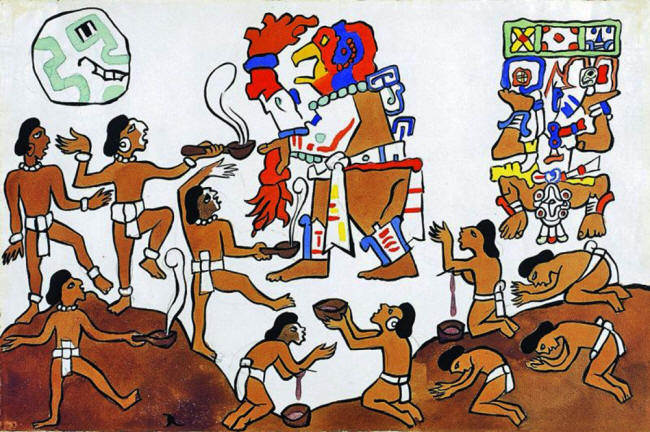|

by Janice Friedman
July 17,
2018
from
Ancient-Code Website

The Popol Vuh which is translated
as the Book of the community or Book of advice is an ancient work of
literature, a collection of mythical, legendary and historical
narratives of the
K'iche people, the Guatemalan Maya
people.
The book, of great historical and spiritual value, has been called
Sacred Book or the Bible of the Mayas by many authors.
It is composed of a
series of stories that try to explain the origin of the world,
of civilization, of various phenomena that occur in nature, etc.
The work is often
described as the only book of the Maya that covers a variety of
topics including creation, ancestry, history, and cosmology.
The Book also delves into the creation myth, how beings created
mankind and mention the great flood.
This is why we can say
that the Popol Vuh is without a doubt the most important ancient
text ever written by the Maya, and which remains in existence.
It is distinguished not only by its extraordinary and vast
historical and mythological content but by its literary qualities
which allow it to be placed at the height of great epic works such
as the Hindu Ramayana or the Greek Iliad and Odyssey.
The Popol Vuh is preserved in a bilingual manuscript written by Fray
Francisco Ximénez, who identifies himself as the
transcriber (of the Maya K'iche version) and translator of an old
"book".
Adrián Recinos, an
author from Guatemala explains that:
"The original
manuscript (Popol Vuh) is not divided into parts or chapters. In
fact, the text runs without interruption from the beginning to
the end."
Nonetheless, the content
of the Popol Vuh can be resumed into the following 'chapters':
-
Creation
-
Histories of
Hunahpú and Ixbalanqué
-
Creation of man
from maize
-
Waiting for dawn
and the permanence in Hacauitz
-
Migration stories
-
Founding of
Gumarcah and List of generations
In this article, we take
a look at 'the creation story' offered by the Maya and what is
written down in the Popol Vuh.
We find that the sacred Maya book mentions 'beings' who
created mankind...
The beings who are
said to have created mankind are referred to in the Popol Vuh as,
"the Creator, the
Former, the Dominator, the Feathered-Serpent, they-who-engender,
they-who-give-being, hovered over the water as a dawning light."
The creation
myth
In the first part of the Popol Vuh, it is written how the 'gods'
raise valleys and mountains from the primordial sea and create
plants and animals.
They decide something was lacking, and therefore they went on to
create beings that venerate them and make offerings to them.
The first three attempts fail according to the
Popol Vuh:
"Our work and
our labor has accomplished its end. The earth then was
covered with various forms of animal life.
And the
Creator and Former said to the animals:
"Speak
now our name!"
But the
animals could not speak as a man.
Then said
their Makers:
"Our
glory is not yet perfect since ye cannot invoke us.
Dens and food shall ye have, but as to your flesh,
it shall be eaten.
This is
your destiny."
"Again there
is counsel in heaven.
"Let us
try again; let us make them who are to be our
vehicles and nourishers."
So the
Creators determined to make man.
Of red earth
they molded his flesh; but when they had made him, they
saw it was not good.
He was
without coherence, strengthless, inept, watery; he had
been endowed with speech, but he had no intelligence,
and straightway he was consumed in the water without
being able to stand upright."
-
In the third
attempt, they make men of wood, but they realize that these
beings are incapable to venerate them, which is why they
decide to punish their arrogance with a hurricane, making
their animals, their tools and the stones of their houses
turn against them.
The Popol Vuh
explains that monkeys are the descendants of the wooden men:
"Again the
gods took counsel. It was decided to make man of the
wood of the tzite cork-tree, and woman of the marrow of
the zibac (willow); but the result was in no wise
satisfactory - they were merely wooden mannikin.
And these are
the people who inhabit the surface of the earth.
They existed
and multiplied, but had neither heart nor intelligence,
nor memory of their Creators. They led a useless life
and lived like the animals.
They were but
an attempt at men."
-
In the fourth
attempt, they achieve their purpose and create man, who was
constructed from maize, the Mayans staple, and sacred food.
The deity Itzamna
is credited as being the creator of the calendar along with
creating writing:
"Once more
the gods commune together and the Creator and Former
made four perfect - wholly of yellow and white maize was
their flesh composed.
The name of
the first was Balam-Quitze; of the second, Balam-Agab;
of the third, Mahucutah; of the fourth, Iqi-Balam."
Here is the interesting
part of the Popol Vuh:
They had neither
father nor mother, neither were they made by the ordinary agents
in the work of creation, but their coming into existence was a
miracle extraordinary, wrought by the special intervention of
the Creator.
"Verily, at last,
did the gods look on beings who were worthy of their
origin."
These men, who know how
to fulfill their obligations to their creators, are able to,
see
everything, in time and space,
...so the gods decide to cloud their
vision.
This is the humanity
that now inhabits the earth...
Therefore we see that in the Popol Vuh, we see that the Creator, the
Former, the Dominator, the Feathered-Serpent, they-who-engender,
they-who-give-being communed on several occasions, and after several
tries,
"THEY" created
MANKIND...
Does that ring a bell...?
|


